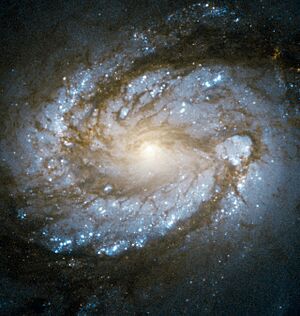Messier 100 facts for kids


Messier 100 (also called NGC 4321) is a beautiful example of a 'grand design' spiral galaxy. This means its spiral arms are very clear and well-defined. You can find it in the southern part of the constellation Coma Berenices.
Messier 100 is one of the brightest and largest galaxies in the Virgo Cluster. It is about 55 million light-years away from us. To give you an idea of its size, it stretches across 160,000 light-years!
A French astronomer named Pierre Méchain first discovered this galaxy in 1781. A month later, Charles Messier also observed it and added it to his famous Messier catalogue of nebulae and star clusters. Messier 100 was one of the first spiral galaxies ever found. In 1850, the Earl of Rosse listed it as one of 14 "spiral nebulae."
Messier 100 has two smaller galaxies orbiting it, like tiny companions. These are NGC 4323 and NGC 4328. NGC 4323 is even connected to Messier 100 by a bridge of glowing gas and dust!
Star Factories
Messier 100 is known as a starburst galaxy. This means it has areas where many new stars are forming very quickly. For at least 500 million years, stars have been born in bursts within a specific part of the galaxy.
Most of this star formation happens in a ring-shaped area. This ring is actually made of two tightly wound spiral arms. These arms are connected to a small bar-shaped structure at the galaxy's center.
In other parts of Messier 100's disk, there are fewer new stars forming. There is also less neutral hydrogen gas, which is needed to make stars. Scientists think this is because of how Messier 100 interacts with other galaxies in the Virgo Cluster.
More Grand Design Galaxies
See also
 In Spanish: Galaxia espiral M100 para niños
In Spanish: Galaxia espiral M100 para niños

